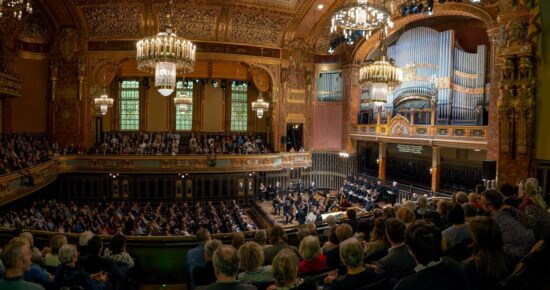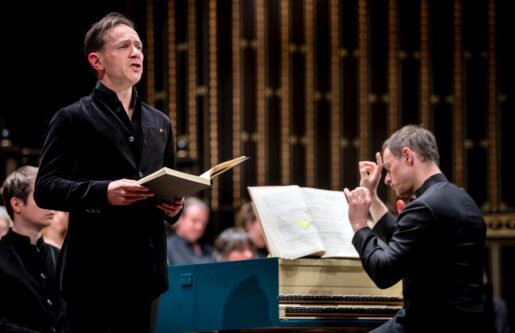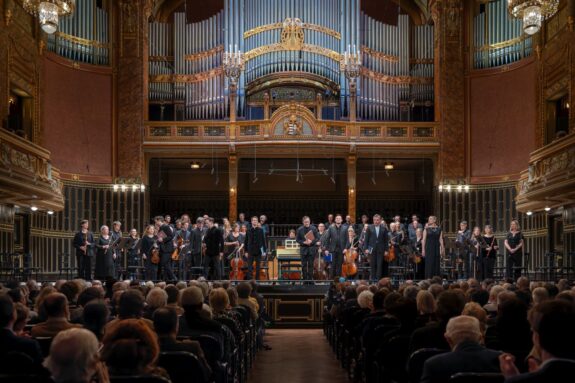 Hungary Bach, St Matthew Passion, BWV 244: Soloists, Orchestra of the Age of Enlightenment / Jonathan Cohen (conductor), Grand Hall of the Music Academy, Budapest, 7.4.2025. (AK)
Hungary Bach, St Matthew Passion, BWV 244: Soloists, Orchestra of the Age of Enlightenment / Jonathan Cohen (conductor), Grand Hall of the Music Academy, Budapest, 7.4.2025. (AK)

Having experienced Salamon Kamp and his Lutheran choir performing St Matthew Passion in a liturgical environment (click here), I am not sure if any performance outside such environment can do full justice to Bach and liturgy.
However, first performed within a Good Friday church service on 11th April 1727 at the Leipzig Thomaskirche, Bach’s masterpiece has entered the concert repertoire after Mendelssohn’s discovery and revival of the composition some hundred years later.
Conductor Jonathan Cohen is a Baroque specialist whose work merits attention in whichever environment. This month he and the excellent London-based Orchestra and Choir of the Age of Enlightenment performed St Matthew Passion in London (3rd April), Budapest (7th April) and Amsterdam (8th April). Much to my disappointment, I was unable to attend the London performance at the Royal Festival Hall, but I was privileged to attend the Budapest repeat.
The Grand Hall of the Budapest Music Academy has about a third of the capacity (under 900) which is available in London’s Royal Festival Hall (2700). Thus, in my view, the Budapest Hall – lovingly restored from its old 1907 self about a decade or so ago – is more suited to intimate masterpieces. Furthermore, it is beautiful.
OAE’s Budapest St Matthew Passion performance was presented by the Bartók Spring festival, an annual series of assumed high standard events. For sure, the standard here was high although not uniform in style by all solo singers.
By all accounts, the star of the performance was tenor Nick Pritchard (Evangelist). He received great praise, rightly so, from critics (both in London and Budapest) for his diction, tonal variety and dramatic interaction with those around him on the stage. Indeed, Pritchard did not only tell the story but physically performed it (mostly from memory) by turning towards those in the drama (like the crowd demanding Jesus’s death, the High Priest and others). His singing as well as acting was done with great skills and taste, but I question the approach: is the Evangelist meant to be telling the story or should he become part of the story?
Bass-baritone Florian Störtz presented a dignified Christ but at times there was some confusion as to who else was Christ, possibly sung from the chorus. Before the interval I wrote in my notebook ‘how many Jesuses?’. My neighbour, a young Hungarian lady, unashamedly kept reading my notes and said to me during the interval: I too was wondering about the Jesus roles.
To my ears, soprano Anna Dennis was very slightly under pitch on a few occasions and in style she was more operatic than Baroque. Baritone Thomas Bauer, possibly more Wagnerian than Baroque singer, presented his arias with clarity and dignity.

Countertenor Iestyn Davies is a shining example of Baroque-style delivery, vocal technique and musical involvement. His voice control enables him to do all what we know about Baroque performance practice and to provide utmost beauty within the confinement of artistic discipline.
The OAE fields some excellent instrumentalists. It is a shame that the programme notes distributed at the Budapest concert did not name any orchestral and chorus members. Yet we had splendid solo contributions from Huw Daniel (leader, first orchestra), Daniel Lanthier (oboe and oboe da caccia, first orchestra), Lisa Beznosiuk (flute, first orchestra), Kati Debretzeni (leader, second orchestra) and Jonathan Manson (cello continuo as well as viola da gamba solos).
Conductor Jonathan Cohen seems to be searching for musical solutions during preparations and rehearsals but also during the process of performing. His is not a carved in stone performance, it is happening and adjusting in real time, with Cohen seemingly fully believing the St Matthew story.
My understanding of the St Matthew Passion music has less harshness and more gentleness in some of the choral numbers, fewer anxious confrontations and more pleas, less staccato and more legato for instruments as well as singers. Last but not least, I found some of Cohen’s tempi faster than how I understand the text and Bach’s music. In particular, the final chorus expresses sorrow and a prayer for Jesus’s final rest, yet Cohen’s tempo felt more like focusing on going forward than on resting.
Admittedly, I might be influenced by the memory of St Matthew Passion performed in 1976 in the same Grand Hall of the Budapest Music Academy where the OAE and Cohen now played. Conducted by Frigyes Sándor, the 1976 performance made it onto LP in 1979 and onto CD in 2001. The majestic slow tempo of the final movement still haunts me.
Notwithstanding my surprise at some of Cohen’s musical choices, I witnessed music making at its best.
Agnes Kory
Featured Image: OAE at the Budapest Music Academy Grand Hall © Andrea Felvégi/Müpa Budapest

I think you’ll find that you were listening to (amongst others) Judas, Peter and Pilate emanating from the Chorus… ‘Theatre’ is a rather significant element of both Passions but as one of my personal authorities on Bach’s vocal music, Philippe Herreweghe, said ‘the music becomes the theatre of this passion.’
Apologies, Mr Huggins…just spotted your reply.
Indeed, I was listening to Judas, Peter and Pilate from the chorus. However, listening to German words while reading surtitles in English and Hungarian – which might not have been always in sync – confused me (and the lady sitting next to me).
Of course, I should have known better…this was not my first encounter with St Matthew Passion.